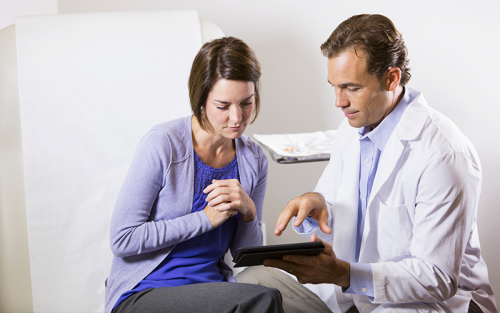Skin cysts are typically caused by an infection, a clogged oil gland or inflammation around an injury or piercing. In most cases, unless they rupture or become infected, they are totally harmless, but that doesn’t mean you’ll want to live with a skin cyst forever.
These smooth, painless, non-cancerous growths slowly form under the skin and are typically filled with fluid, pus or other oily sebaceous material naturally found on the skin’s surface. Though cysts can appear anywhere on the body, they most often show up on the face, neck, and chest. Very rarely, cysts can become cancerous.
If you have a cyst, it may be red or even feel like a pea rolling around under your skin as you move it with your finger. It’s unlikely to cause any discomfort or pain but is also unlikely to go away on its own.
You may choose to get a cyst removed because you want to prevent it from getting infected, because it has grown rapidly or because you dislike it for cosmetic reasons. Removal will require a trip to the dermatologist, who can help you get rid of a cyst right way. Your dermatologist will instruct you how to get rid of a cyst the right way and help you choose the best option for you.
“If you want to have a cyst removed, you should discuss your options with your dermatologist,” says Dr. Sital Patel of U.S. Dermatology Partners Mueller. “A dermatologist can recommend the best treatment for you, which could include actions such as in office excision, steroid injection, incision, and drainage, plus taking antibiotics to help with the inflammation.”
Have it drained with a scalpel.
Cysts that have become painful and infected or have ruptured can be drained by your dermatologist under local anesthesia. Your doctor will sterilize the skin, then pierce the cyst with a scalpel or needle — often under the guidance of ultrasound. The pus or fluid will then be drained from the growth until the walls of the cyst collapse.
This quick procedure takes just a few minutes and typically requires no bandage. Your doctor will sometimes send the fluid from the cyst to a lab to confirm that it is not cancerous. Simply draining a cyst does not guarantee that it will not return. To ensure a cyst does not regrow, the wall of the cyst must also be completely removed.
Shrink it with steroids.
Inflamed and painful cysts can sometimes be treated with a quick injection of a steroid such as cortisone, which will reduce inflammation and cause the cyst to shrink almost immediately. The downside of this option is that although the cyst itself may no longer be visible, the cell wall will still be present after the injection, so the cyst could (and probably will) come back.
Cortisone injections are a common treatment for cystic acne. The steroid injections reduce inflammation, which causes the swelling and pain that comes along with acne cysts. When injected with cortisone, acne cysts typically shrink within hours of the procedure with little or no bleeding, bruising or scarring.
Have it removed surgically.
If your cyst does not respond to other treatments, or if it is causing pain or other symptoms, it may need to be removed surgically under a local anesthesia. Your doctor will typically draw an oval around the cyst with a skin marker, make a small incision on each side of the lesion (or a single incision down the middle) and then carefully remove the cyst and surrounding tissue.
Usually, the cyst can be surgically removed in one piece. Occasionally, the lesion will be fragmented and the remaining tissue of the cyst will need to be cauterized.
After surgery, the wound may require a few stitches, depending on the size of the incision. You may need to return to your doctor’s office at a later time to have the stitches removed. This quick, safe, painless surgical procedure is performed at your doctor’s office. Most surgically removed cysts do not return.
Follow up with antibiotics.
After a cyst has been drained or surgically removed, your doctor may prescribe oral or topical antibiotics to reduce the risk of infection. Flucloxacillin is a common oral penicillin antibiotic used to treat bacterial infections and is often prescribed to treat or prevent infections of cysts.
If your doctor prescribes an antibiotic, it is important to continue taking all of the medication as prescribed until the course is finished, even if your infection has cleared. This will prevent the infection from returning.
After a cyst is removed, keep the area clean and dry so it can heal without developing an infection. If you have stitches after surgery or a bandage and dressing on the wound, carefully follow the instructions given to you after your procedure. Your doctor will let you know when the dressing can be removed and how long you’ll need to wait before getting your incision wet in the shower.
Most cysts are harmless and can be left alone, but if a cyst does need to be removed, always consult with your doctor. Never try to drain or remove a cyst on your own. Trying to handle a cyst at home could lead to infection and permanent scarring.
Looking to Visit a Dermatologist?
If you have a cyst that may require medical attention, contact a dermatologist at U.S. Dermatology Partners today to learn more about treatment options. Our team uses state-of-the-art technology and resources to provide you with the best possible care. We have multiple locations throughout the country, so fill out our simple online form to get in touch with us. One of our local team members will reach out to you shortly to answer your questions or schedule an appointment for you to visit us soon.
Find a location near me
or

